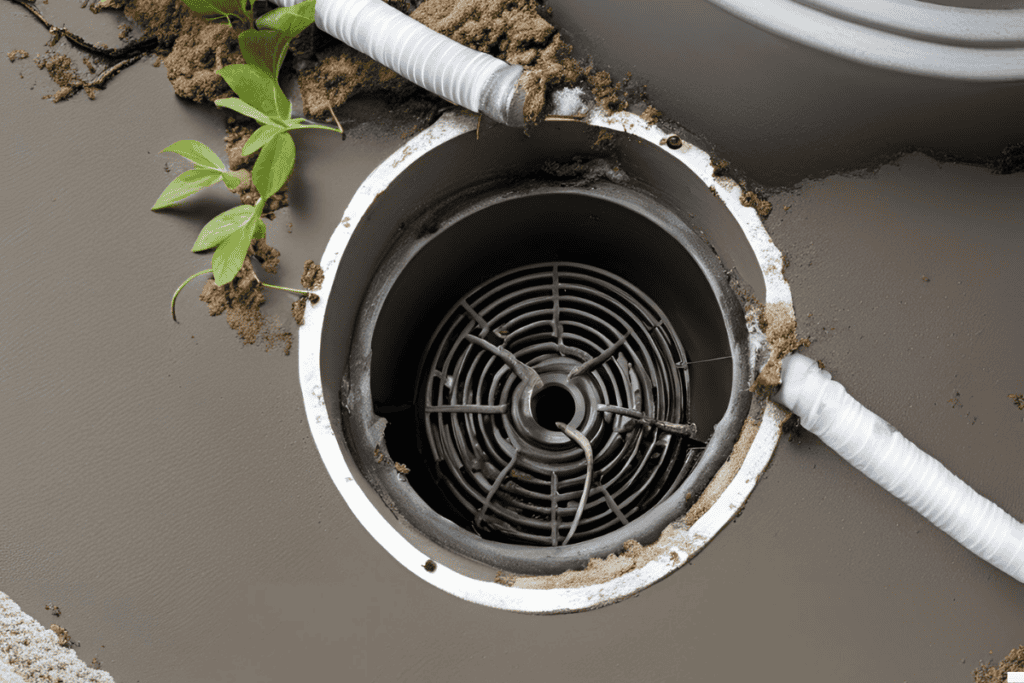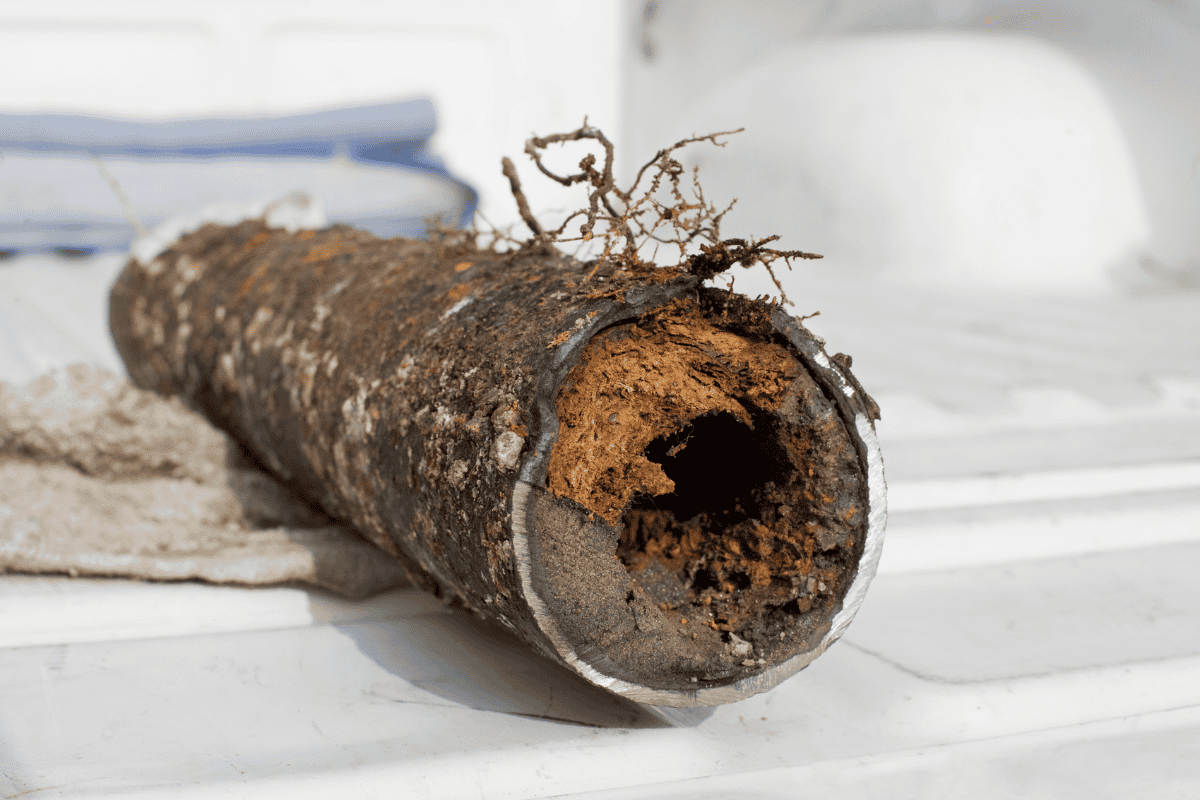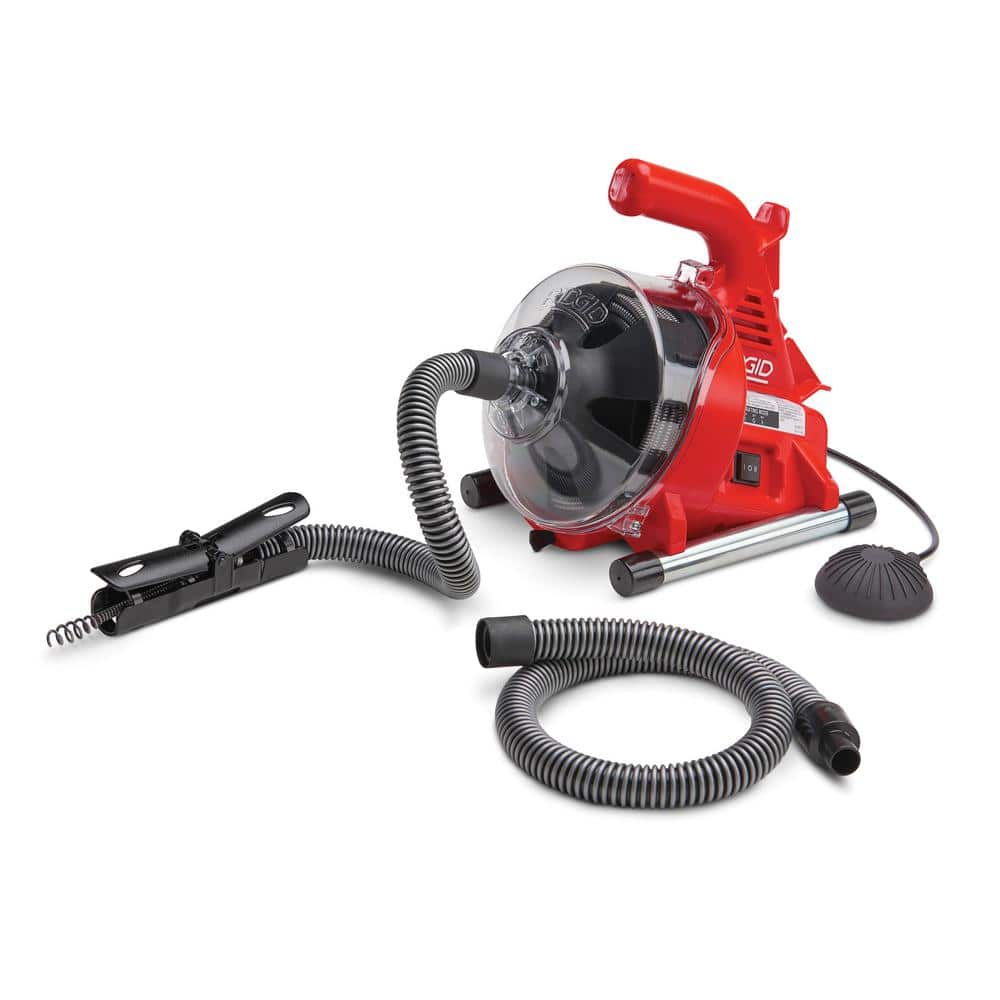How to Clean Clogged AC Drain Line At Home [Expert’s Guide]

Is your air conditioner not cooling as efficiently as it should? Have you noticed water pooling around your AC unit or a musty smell in your home? It could be a sign that the ac system’s drain line is clogged.
If so, you may have a clogged AC drain pipe, indicating that your ac won’t be able to function properly until it is cleared. The AC drain line is a small pipe that transports water and debris from the drain pan to a drain or outdoors, removing excess moisture produced during the cooling process.
According to the International Mechanical Code (IMC), the diameter inside of your drain lines must be at least ¾ of an inch to ensure proper functionality.
When this pipe becomes clogged, it can lead to a messy situation and cause your air conditioner to malfunction. A clogged drain line occurs when debris, such as dirt, dust, and mold, accumulates inside the pipe, restricting the flow of condensate.
If left untreated, a blocked AC drain line can result in water damage to your home, increased humidity levels, and even costly repairs to your air conditioning unit.
Contents
5 Signs of a Clogged Condensate Drain Line
Now that you understand the importance of a properly functioning AC drain line, it’s crucial to recognize the signs of a clog. According to the International Mechanical Code (IMC), the outlet of the condensate pan should be larger than that of the drain lines to promote good drainage of the water. If you notice any of the following symptoms, it’s likely that your AC drain line is clogged.
1. Water collected in the AC drain pan: If you see standing water in the drain pan, it’s a clear indication that the condensate is not draining properly due to a blockage in the ac system’s drain line.
2. Stagnant water near the unit: Pooling water around your AC unit is another sign that the drain line is clogged, causing the condensate to overflow and accumulate near the base of the unit.
3. Rust along the base of the unit: When water consistently leaks from a clogged drain line, it can cause rust to form along the base of your air conditioning unit, which can lead to more serious damage if left unaddressed.
4. Musty smell from the vents: A blocked AC drain line can create an ideal environment for mold and mildew growth, resulting in a musty smell emanating from your air conditioner’s vents.
5. AC system is not cooling your home: If your air conditioner is running but not effectively cooling your home, a clogged drain line may be the culprit, as the unit may be working harder to compensate for the blockage.

6. AC system shuts down or doesn’t turn on: In some cases, a severely clogged AC drain line can cause your air conditioning unit to shut down completely or prevent it from turning on, as a safety measure to prevent further damage.
What Can Cause an AC Drain Line to Clog
Several factors can contribute to a clogged AC drain line, which can lead to various issues with your air conditioning system. One of the primary causes is the buildup of algae, mold, or mildew in the drain line.
When warm air blows over the cool evaporator coil of your AC, the condensate line becomes quite humid creating an ideal environment for these organisms to thrive, clogging the pipe.
According to the Centers for Disease Control and Prevention (CDC), exposure to mold can cause allergic reactions and other health problems.
Over time, dust and debris can also accumulate in the drain line, further restricting the flow of condensate and exacerbating the clog.
As the system’s drain line becomes more clogged, the water backs up into the drain pan and eventually overflows, causing water damage and potential issues with your AC unit’s performance.
How To Clean an AC Drain Line
Method 1: Using Vinegar
1. Turn Off Your Air Conditioner
Before beginning the cleaning process, turn off your air conditioning unit for your safety and prevent any damage to the system. Locate the thermostat and switch it to the “off” position, or turn off the power supply to the AC unit at the circuit breaker.
2. Identify the Drain Line
The AC drain line is typically a PVC pipe that runs from your indoor air handler to the outside of your home. The drain line may be located near the foundation of your house or in your basement, depending on the location of your HVAC system.
3. Find the Access Point
Once you’ve located the drain line, find the access point, which is usually a T-shaped vent with a cover that can be removed by hand or with a screwdriver. This access point allows you to clean the drain line without disconnecting any pipes.
4. Pour in Diluted Vinegar or Bleach Solution

To clean the drain line, create a solution of equal parts water and white vinegar or bleach. Slowly pour the mixture into the drain line through the access point, allowing it to work through the pipe and break down any clogs or buildup. Let the solution sit for about 30 minutes.
5. Flush the Line
After letting the cleaning solution sit, flush the drain line with hot water to rinse away any remaining debris and the cleaning solution. Pour the hot water into the access point and let it run through the pipe for several minutes for thorough cleaning.
6. Monitor the System’s Performance
Once you’ve completed the cleaning process, turn your air conditioner back on and monitor its performance over the next few days.
Method 2: Use Chemical Drain Cleaners
Chemical drain cleaners are another popular way to unclog an AC drain line. These products are designed specifically to break down clogs in your air conditioner’s drain line, making them an effective solution for a clogged condensate drain line.
These chemicals come in powdered form and need to be mixed with water before being poured down the drain line’s access point. After applying the chemical cleaner, you’ll need to leave it in place for several hours to allow it to work its way through the clog and dissolve any debris inside the line.
Though these chemicals work well in unclogging the drain pipes, they pose great danger to the environment. It is suggested to use them as rarely as possible.
Method 3: Use An Electric Snake
An electric snake, also known as a plumber’s snake or a drain auger, is a long, flexible machine with an attachment on one end that allows you to push it down the AC’s drain line. The other end of the wire has a rotating brush that dislodges any debris in the drain line, effectively breaking up the clog and allowing water to drain freely once again.
Electric snakes are highly effective at unclogging a drain line, but they require some plumbing and electrical work knowledge before you can use one safely.

Call HVAC Angel For A Clog-Free Drain
If you’ve tried the above-mentioned solutions and your AC drain line is still clogged, it’s time to call in the professionals at HVAC Angel. Our team of experienced HVAC technicians has the knowledge and tools necessary to quickly diagnose and resolve even the most stubborn drain line blockages.
When you choose HVAC Angel for your AC maintenance needs, you can trust that we’ll provide top-notch service at a fair price. Our technicians are highly trained and experienced in unclogging AC drain lines, making sure that your system is functioning at its best.
Contact HVAC Angel today to schedule AC maintenance and enjoy the peace of mind that comes with a clog-free drain.
Frequently Asked Questions (FAQs)
1. What is the purpose of the AC drain line?
The AC drain line, or condensate drain line, removes moisture that accumulates during the cooling process, preventing water damage and maintaining indoor air quality.
2. Is bleach or vinegar better for AC drain line?
Both bleach and vinegar can effectively clean AC drain lines, but vinegar is safer and more environmentally friendly. Dilute either solution with water and flush the line thoroughly.
3. Where are AC drain lines located?
AC drain lines are usually found near the indoor air handler unit, typically in a utility closet, basement, or attic, running from the condensate drain pan to an exterior wall or floor drain.
